
Score breakdown
Things we like
- Diesel has lots of grunt
- Roomy rear seat
- Value despite price increase
Not so much
- Prices have risen by $4000
- Vague steering and firm ride
- Still missing key safety gear like auto emergency braking and blind-spot monitoring
Well, you certainly can’t accuse LDV of resting on its laurels.
Less than a year after it gave its T60 dual-cab ute a major overhaul that added a vastly more powerful diesel engine, a revised cabin and tougher exterior styling – as well as a name change to T60 Max – the Chinese brand has once again treated its ute to some improvements.
For the MY23 model year, LDV has added a host of visual and equipment upgrades to its increasingly popular dual-cab (almost 24,000 T60s have been sold here since 2017) and it has also brought back the larger and more practical ‘Megatub’ body style, which has been absent from the range.
The warranty has also been improved, jumping from five years or 130,000km to seven years or 200,000km.
But there’s a sting in the tail. The update also brings another price rise.
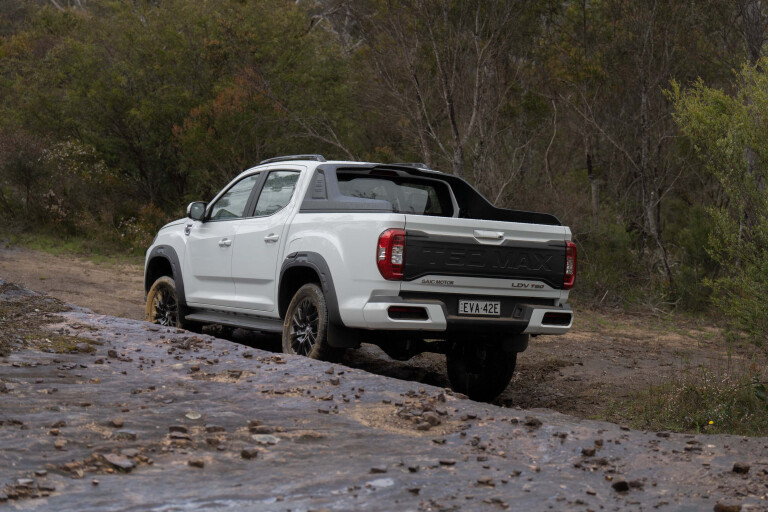
When LDV last updated the T60 back in November 2021, it raised prices by around $5000 and this time they’ve lifted them again to the tune of another $4000.
Add those together and the price of one of Australia’s most affordable utes has spiked by almost $10,000 in under a year.
So should you still consider one? And does it still represent good bang for your buck? We jumped aboard a T60 Max Luxe to find out.

JUMP AHEAD
- How much is it and what do you get?
- How do rivals compare on value?
- Interior comfort & space
- What’s it like to drive?
- Warranty & running costs
- VERDICT
- Specifications
How much is it and what do you get?
Outright value has long been core to the T60’s appeal and, despite the recent price increases, that continues with this updated model.
As before, there are two versions of the T60 Max to choose from and each has a slightly different focus.
The entry-level Pro is more of a workhouse and is fitted with heavier-duty suspension that lifts its payload to 935kg. Drive-away prices start at $41,042 for the six-speed manual or $43,148 in eight-speed automatic guise (prices for ABN holders are $38,990 and $40,990 respectively).
We’re testing the T60 Max Luxe which has a softer suspension tune, a payload of 750kg and a stronger focus on everyday comfort and luxury. Luxe pricing kicks off at $45,770 drive-away for the manual but our test ute is the eight-speed auto, which retails for $47,884 drive-away. ABN holders can snap up a Luxe for $43,490 (manual) and $45,490 (automatic).
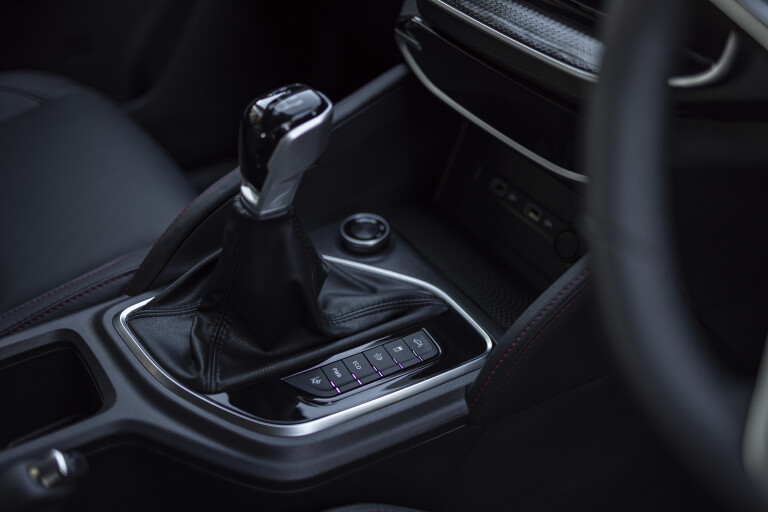
Those prices represent a $4210 increase across the board for private buyers or $4000 more for ABN holders, so what do you get for your extra cash?
Well if you were hoping for more grunt or an efficiency boost, prepare to be disappointed. Mechanically, the MY23 T60 Max is identical to the outgoing ute but given it already boasts one of the most powerful four-cylinder diesels of any dual-cab, that’s no bad thing.
The 2.0-litre twin-turbo diesel produces 160kW and 500Nm, meaning it trumps both the Ford Ranger bi-turbo (157kW/500Nm) and Toyota HiLux 2.8-litre turbo-diesel (150kW/500Nm) for on-paper performance.
Class-leading grunt for significantly less cash than a Ranger and HiLux? Not bad.

Where this MY23 update doubles down on adding additional value is through extra equipment. Pro versions gain side steps, chrome roof rails and a stainless steel sports bar as standard.
The Luxe also gets sidesteps but adds black roof rails, a black sailplane, black wheelarches, body colour wing mirrors, a soft-release tailgate and larger black 19-inch alloys shod in higher quality Continental tyres that replace the previous 17-inch wheels and Giti rubber.
LDV claims Pro models have $2600 worth of additional value while the Luxe gains $5000 of inclusions as standard.

It has some notable omissions, however.
Autonomous emergency braking (AEB) is still not included on any T60 Max model. And other key active safety equipment, such as blind-spot monitoring, rear-cross traffic alert, adaptive cruise control and forward collision warning is also absent.
The T60 Max does carry a five-star ANCAP rating, however, it was achieved back in 2017. Under today’s stricter testing protocols, it’s unlikely the T60 would be a five-star vehicle.
Equipment-wise, there are some key differences between the Pro and Luxe model grades. Both feature a part-time 4x4 system but the Luxe benefits from an on-demand rear diff lock. Other equipment highlights for the Luxe include:
| Keyless entry and start | 10.25-inch central screen |
| 360-degree cameras | Apple CarPlay |
| Lane departure warning | Tyre pressure monitor |
| Rain sensing wipers | Rear on-demand diff lock |
| Auto LED headlights | Rear parking sensors |
| Black wheelarches | Reversing camera |
| Leather-trimmed seats | 19-inch alloys |
How do rivals compare on value?
There are several contenders in the sub-$50K dual-cab market worth considering.
Perhaps the most obvious rival to the LDV is the GWM Cannon which starts at just $38,990 drive-away. To get an equivalent level of spec and equipment to a T60 Max Luxe, however, you’ll need to look at a flagship GWM Cannon-X that starts at $45,490 drive-away.
That makes it about $2500 less expensive than at the LDV and the Cannon-X includes a host of standard equipment like genuine leather seats, LED headlights, 360-degree surround-view cameras and a comprehensive suite of active safety systems.
It can’t match the T60 Max for grunt, though. Its single-turbo 2.0-litre diesel produces 120kW/400Nm, which is well down on the segment average let alone LDV’s 160kW/500Nm.
The Mitsubishi Triton GLX+ is another strong contender at this end of the market. Pitched at $43,940 before on-road costs, it is powered by a dependable 2.4-litre turbo-diesel and offers superior on-road dynamics. It’s a solid all-rounder and while it lacks the headline-grabbing power figure of the LDV and outright value of the GWM, we’d argue it’s a smarter buy if you’re looking for a dependable and proven sub-$50K dual-cab.
A final value-focused rival worth mentioning? The SsangYong Musso. For $43,590 drive-away you can score a flagship Ultimate XLV that offers a more convincing and comfortable cabin (with soft Nappa leather seats and dual-zone climate if you opt for the Luxury Pack), a quiet and gutsy 2.2-litre turbo-diesel and a huge tray that’s extended by 300mm and offers a payload of 880kg.
In a battle between the LDV, GWM and SsangYong, we’d recommend the SsangYong by some margin.
Interior comfort & space
It might be a budget-focused ute but, initially at least, the T60 Max certainly doesn’t feel cheap when you jump inside the cabin.
Both front seats are leather-trimmed and electrically adjustable, you score a 360-degree surround-view monitor, there’s a large 10.25-inch central touchscreen and the steering wheel now features an updated design that includes shift paddles for auto versions. The general ambience and design is also pleasing and ergonomically all of the major controls fall easily to hand.
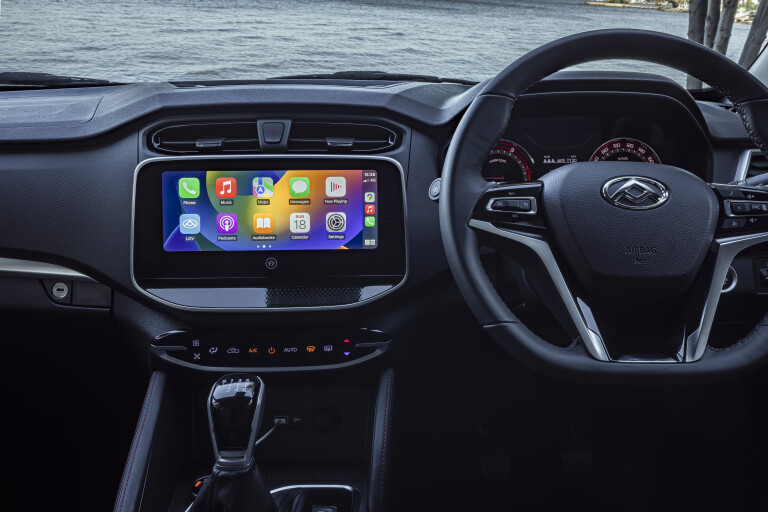
Clear instruments and ample interior storage, courtesy of large door bins and two central cup holders, are other strengths. Connectivity is decent, too, thanks to twin USB-A ports and standard (wired) Apple CarPlay. Android Auto isn't featured natively, but the local distributor tells us: "it can be accessed via the Q-link system in the car central screen".
The large central screen is also quick to respond and features clear graphics, although the resolution of the reversing camera isn’t as high as some rivals.
There are other missteps, too. There’s no reach adjustment for the steering wheel so the driving position always feels a touch off, no matter how you adjust the six-way electric seat and the seat itself lacks under-thigh support, which could be an issue on long trips.
While the general sense of quality is acceptable, it’s easy to encounter hard and scratchy interior plastics.
The back seat is impressively roomy, though. Some dual-cab utes have squishy second rows but the T60 Max can easily ferry about four six-foot adults in relative comfort.
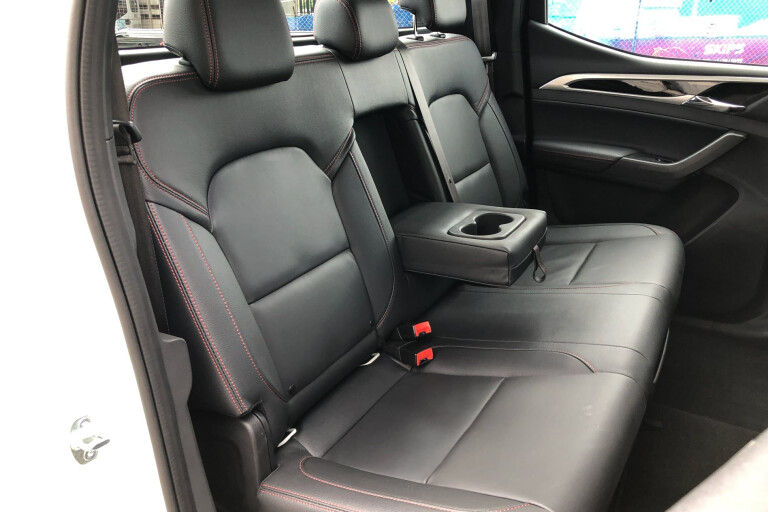
Cargo hauling
As for its ability to lug a load, the T60’s tray is well-sized and measures 1525mm (L) x 1519mm (W) x 530mm (H), with 1131mm between the wheelarches. A spray-in tub liner is also included, as are four tie-down points.
There’s a large step below the tailgate, too, which is useful for reaching things in the back without dropping the soft-release tailgate.
One key thing to remember is the Luxe has a payload of 750kg, making the Pro’s 935kg payload the variant to pick if you intend to load up the tray with heavy items for work or long camping trips.

What’s it like to drive?
This is where the T60’s appeal starts to dip a touch. Our stint behind the wheel took in some low-speed urban sections and quicker country roads, where we discovered that there’s certainly room for improvement when it comes to dynamics.
As well as the lack of reach adjustment for the steering wheel making the driving position less than ideal, the steering itself also lacks feel and has a large dead spot off centre.
It’s not void of feedback – there’s actually quite a lot of vibration and kickback that comes back through the wheel – it’s just lacking the kind of feel and connection you want as a driver.
The unladen ride is also skittish and stiff-legged on larger 19-inch wheels, despite the Luxe’s more comfort-oriented suspension set-up. We’re yet to test the T60 Max with a load in the back to see if that improves things.
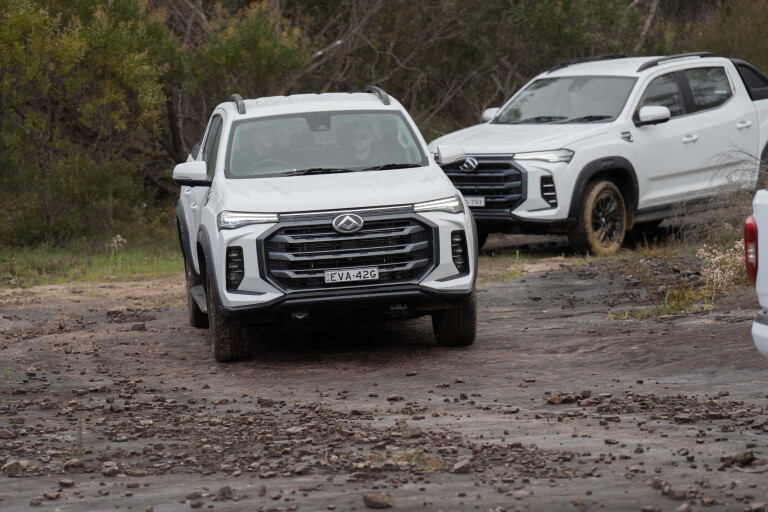
Happily, road noise is pretty well contained and there’s also a subtle improvement in engine-noise intrusion when the 2.0-litre turbo-diesel is at idle.
An LDV spokesperson confirmed this update has brought some additional sound deadening to the engine bay.
But for all its on-paper performance, it’s actually quite tricky to tap into the engine’s full potential. Max power is made high in the rev range and the powertrain can feel sluggish below 2500rpm. It also suffers from noticeable lag, especially when accelerating away from a standstill.
On the move, it’s easier to tap into the muscular top-end thanks to the quick-shifting ZF eight-speed automatic (overtaking performance is reassuringly strong) but the diesel unit can get quite vocal under heavy load.

The powertrain’s peaky nature is also a weakness off-road. During steep low-speed inclines or when tackling trickier obstacles, it can be difficult to maintain a constant throttle as the engine comes on and off boost. We only encountered this issue when the 4X4 system was left in 4Auto, however. Switching over to 4Low did improve things.
Some improvements to its traction control systems would also benefit the T60, especially in off-road scenarios where they can feel heavy-handed. They’re also surprisingly noisy and lack the sophistication of something like a Ford Ranger.
In fact, in just about every dynamic discipline the T60 is towards the bottom of the current dual-cab pack. The good news is that LDV’s track record shows it’s willing to quickly update and improve its products. Here’s hoping the next iteration benefits from some additional dynamic polish and refinement.

Warranty & running costs
The LDV T60 has one of the longest warranty periods of any new dual-cab. Previously LDV’s warranty stood at the industry-standard five years but for the 2023 model year, the T60 Max now comes with a warranty that lasts seven years or 200,000km.
Service intervals are every 12 months or 15,000km, whichever occurs first. LDV currently doesn’t offer any capped-price servicing plans.
As for fuel use, the official combined consumption figure is 9.3L/100km for automatic versions and 9.2L for models fitted with the six-speed manual. Every T60 Max has a 73-litre fuel tank.

VERDICT
LDV is quickly gaining sales momentum with the T60 Max and it’s easy to see why.
It looks tough, it’s well equipped and there’s ample performance on tap thanks to its headline-grabbing outputs of 160kW/500Nm.
Throw in a nicely calibrated eight-speed auto, a roomy back seat and an aggressively low price tag and the T60 mounts a convincing case for buyers looking to maximise bang for their buck.
But the recent price rises, laggy engine performance, sub-par safety credentials and below-average on-road ride and handling undermine what could be a seriously compelling package.
2023 LDV T60 Max specifications
| Body | 4-door, 5-seat dual-cab ute |
|---|---|
| Drive | part-time four-wheel |
| Engine | 1996cc inline 4cyl twin-turbo diesel |
| Compression | 15.9:1 |
| Bore/stroke | 83 x 92mm |
| Power | 160kW @ 4000rpm |
| Torque | 500Nm @ 1500-2400rpm |
| Transmission | 8-speed automatic |
| Weight | 2150kg |
| Fuel consumption | 9.3L/100km |
| Front suspension | struts, double A-arms, coils springs, anti-roll bar |
| Rear suspension | Leaf springs, anti-roll bar |
| L/W/H | 5365/1900/1809mm |
| Wheelbase | 3155mm |
| Payload | 750kg |
| GVM | 2900kg |
| Towing capacity | 3000kg braked |
| Tyres | Continental 255/55 R19 |
| Wheels | 19-inch alloy |
| Price | $47,884 drive-away |
Score breakdown
Things we like
- Diesel has lots of grunt
- Roomy rear seat
- Value despite price increase
Not so much
- Prices have risen by $4000
- Vague steering and firm ride
- Still missing key safety gear like auto emergency braking and blind-spot monitoring


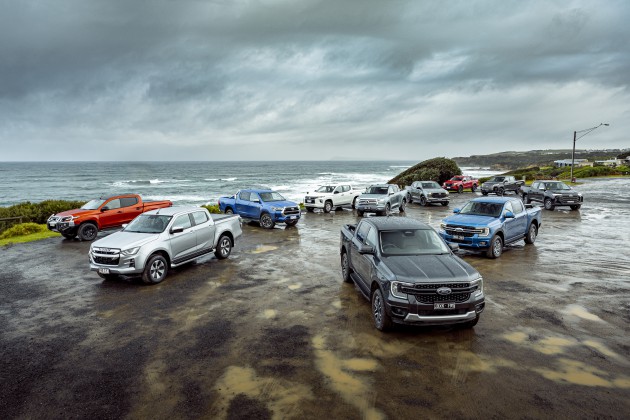

COMMENTS